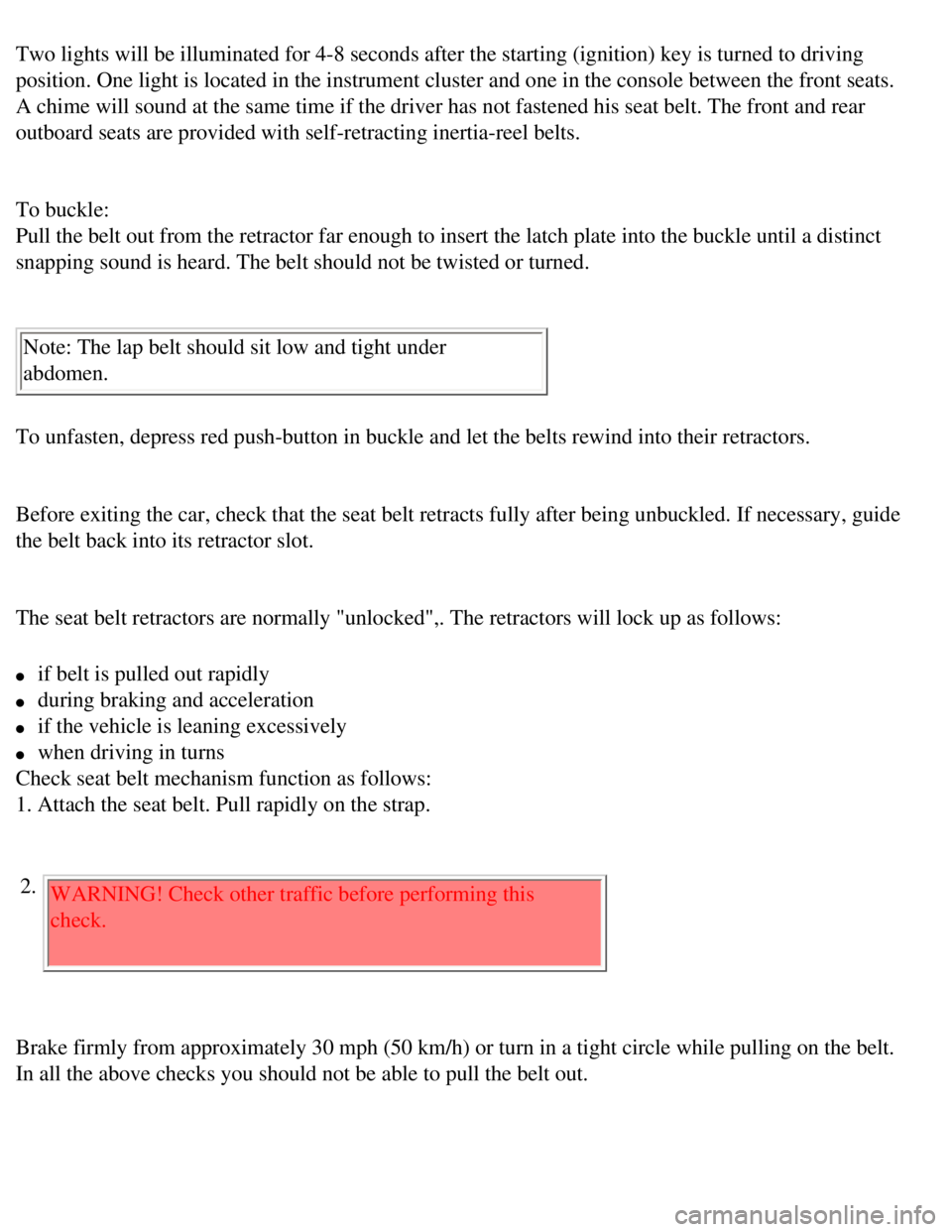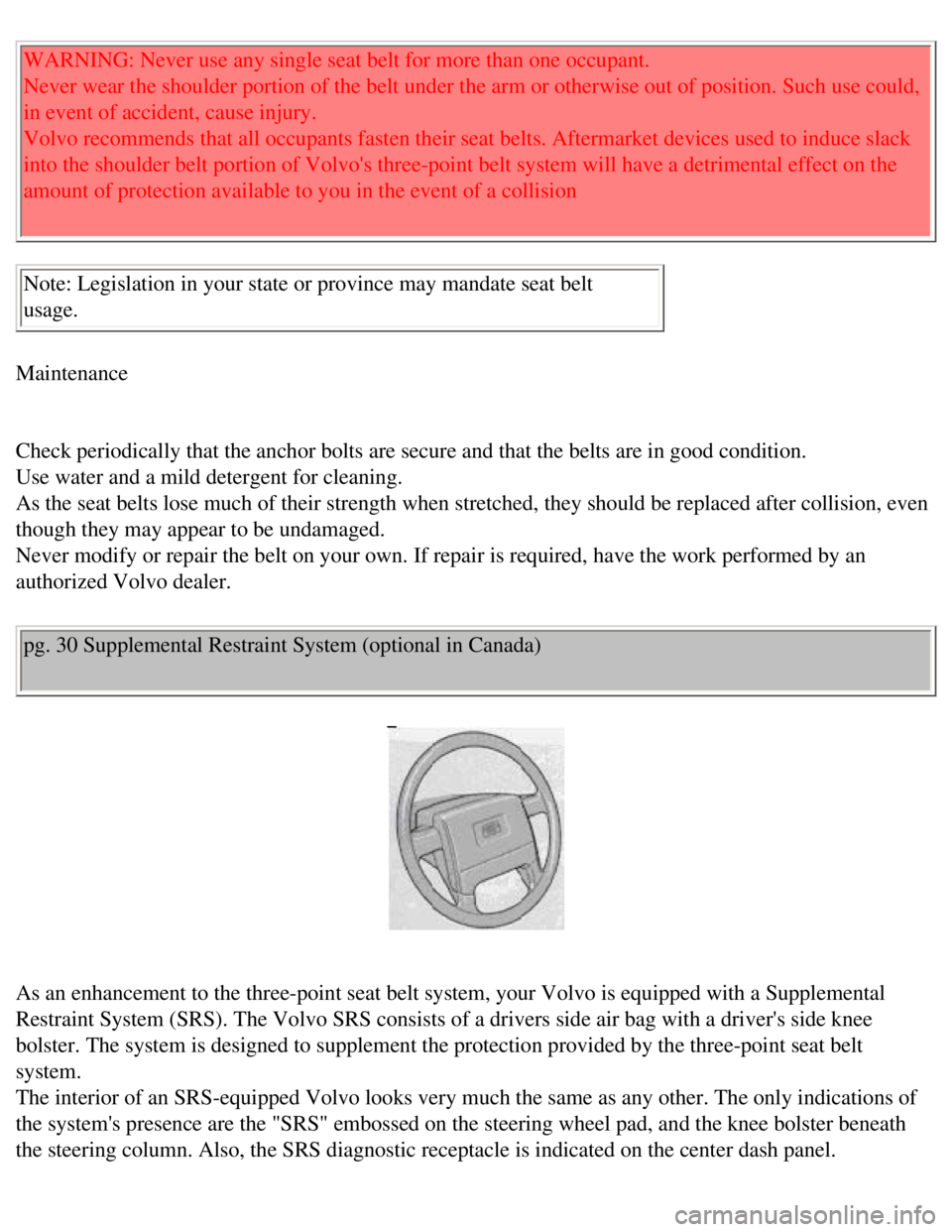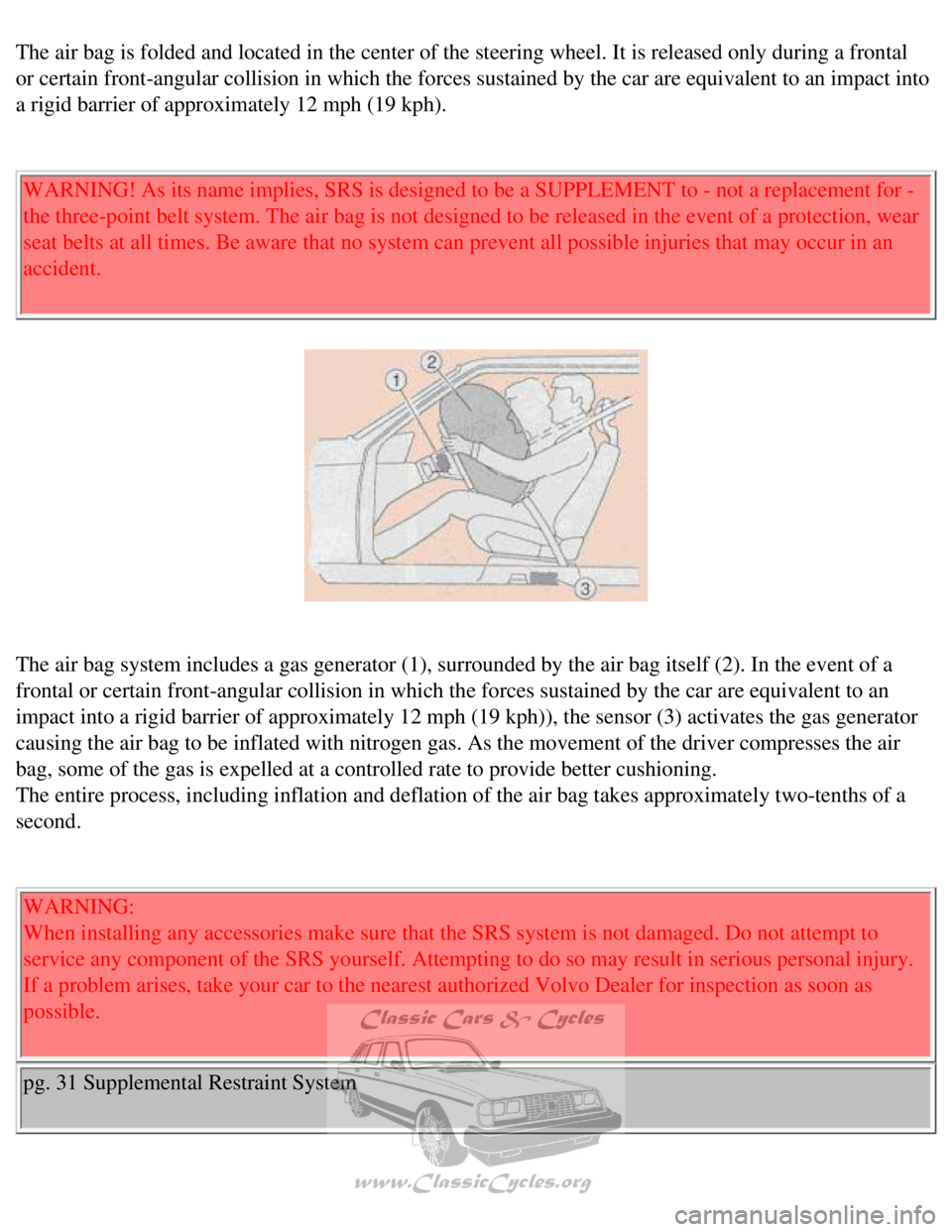Page 22 of 143
Volvo 1990 240 Model
cleaner, otherwise damage to the printed circuit will occur.
Hazard warning flasher
The four-way flasher should be used to indicate that the vehicle has bec\
ome a traffic hazard.
Note: Regulations regarding the use of the hazard warning flasher may va\
ry from state to
state.
pg. 19 Parking brake
Parking brake (hand brake)
The lever is situated between the front seats. The brake is applied to t\
he rear wheels.
The PARKING BRAKE reminder light on the instrument panel comes on whenev\
er the parking brake
lever is not fully released and the ignition is on.
Always use the parking brake (hand brake) when parked.
In order to obtain the best possible performance of the parking brake, t\
he brake linings should be broken
in. (See section titled "Break-in period".)
file:///K|/ownersdocs/1990/1990_240/90240_04.htm (2 of 5)12/30/2006 8:\
25:02 AM
Page 25 of 143
Volvo 1990 240 Model
Warning: Remove the starting (ignition) key from the car when children\
are left alone in the
car.
Cut-out switch for rear-door electrically-operated windows
If the car is equipped with rear-door power windows, this function can b\
e disabled by a switch located
on the driver's door armrest. This switch is positioned 90° in relati\
on to the other switches.
The rear door windows can be raised or lowered with the respective door \
switch as well as the switch on
the driver's door.
The rear-door windows cannot be raised or lowered with the respective do\
or switch but instead only
with the corresponding switch on the driver's door.
Contents | Top of Page
file:///K|/ownersdocs/1990/1990_240/90240_04.htm (5 of 5)12/30/2006 8:\
25:02 AM
Page 34 of 143
Volvo 1990 240 Model
Place the top tether anchorage plate as shown in the illustration. Using\
the M8 bolt, tighten securely, to
16 i 2.5 ft. lbs. Place the plastic trim plate over the anchorage plate,\
if desired.
WARNING!
Child Restraint Anchorages are designed to withstand only those loads im\
posed by correctly fitted
Child Restraints. Under no circumstances are they to be used for adult s\
eat belts or harnesses.
The anchorages are not able to withstand excessive forces on them in the\
event collision if full harness
seat belts or adult seat belts are installed to them.
An adult who uses a belt anchored in a Child Restraint Anchorage runs a \
great risk of suffering severe
injuries should a collision occur.
pg. 28 Seat belts
Seat belts, retractable
Always fasten the seat belts before you drive or ride.
file:///K|/ownersdocs/1990/1990_240/90240_06.htm (3 of 9)12/30/2006 8:\
25:04 AM
Page 35 of 143

Volvo 1990 240 Model
Two lights will be illuminated for 4-8 seconds after the starting (igni\
tion) key is turned to driving
position. One light is located in the instrument cluster and one in the \
console between the front seats.
A chime will sound at the same time if the driver has not fastened his s\
eat belt. The front and rear
outboard seats are provided with self-retracting inertia-reel belts.
To buckle:
Pull the belt out from the retractor far enough to insert the latch plat\
e into the buckle until a distinct
snapping sound is heard. The belt should not be twisted or turned.
Note: The lap belt should sit low and tight under
abdomen.
To unfasten, depress red push-button in buckle and let the belts rewind \
into their retractors.
Before exiting the car, check that the seat belt retracts fully after be\
ing unbuckled. If necessary, guide
the belt back into its retractor slot.
The seat belt retractors are normally "unlocked",. The retractors will l\
ock up as follows:
l if belt is pulled out rapidly
l during braking and acceleration
l if the vehicle is leaning excessively
l when driving in turns
Check seat belt mechanism function as follows:
1. Attach the seat belt. Pull rapidly on the strap.
2. WARNING! Check other traffic before performing this
check.
Brake firmly from approximately 30 mph (50 km/h) or turn in a tight ci\
rcle while pulling on the belt.
In all the above checks you should not be able to pull the belt out.
file:///K|/ownersdocs/1990/1990_240/90240_06.htm (4 of 9)12/30/2006 8:\
25:04 AM
Page 37 of 143

Volvo 1990 240 Model
WARNING: Never use any single seat belt for more than one occupant.
Never wear the shoulder portion of the belt under the arm or otherwise o\
ut of position. Such use could,
in event of accident, cause injury.
Volvo recommends that all occupants fasten their seat belts. Aftermarket\
devices used to induce slack
into the shoulder belt portion of Volvo's three-point belt system will h\
ave a detrimental effect on the
amount of protection available to you in the event of a collision
Note: Legislation in your state or province may mandate seat belt
usage.
Maintenance
Check periodically that the anchor bolts are secure and that the belts a\
re in good condition.
Use water and a mild detergent for cleaning.
As the seat belts lose much of their strength when stretched, they shoul\
d be replaced after collision, even
though they may appear to be undamaged.
Never modify or repair the belt on your own. If repair is required, have\
the work performed by an
authorized Volvo dealer.
pg. 30 Supplemental Restraint System (optional in Canada)
As an enhancement to the three-point seat belt system, your Volvo is equ\
ipped with a Supplemental
Restraint System (SRS). The Volvo SRS consists of a drivers side air b\
ag with a driver's side knee
bolster. The system is designed to supplement the protection provided by\
the three-point seat belt
system.
The interior of an SRS-equipped Volvo looks very much the same as any ot\
her. The only indications of
the system's presence are the "SRS" embossed on the steering wheel pad, \
and the knee bolster beneath
the steering column. Also, the SRS diagnostic receptacle is indicated on\
the center dash panel.
file:///K|/ownersdocs/1990/1990_240/90240_06.htm (6 of 9)12/30/2006 8:\
25:04 AM
Page 38 of 143

Volvo 1990 240 Model
The air bag is folded and located in the center of the steering wheel. I\
t is released only during a frontal
or certain front-angular collision in which the forces sustained by the \
car are equivalent to an impact into
a rigid barrier of approximately 12 mph (19 kph).
WARNING! As its name implies, SRS is designed to be a SUPPLEMENT to - no\
t a replacement for -
the three-point belt system. The air bag is not designed to be released \
in the event of a protection, wear
seat belts at all times. Be aware that no system can prevent all possibl\
e injuries that may occur in an
accident.
The air bag system includes a gas generator (1), surrounded by the air\
bag itself (2). In the event of a
frontal or certain front-angular collision in which the forces sustained\
by the car are equivalent to an
impact into a rigid barrier of approximately 12 mph (19 kph)), the se\
nsor (3) activates the gas generator
causing the air bag to be inflated with nitrogen gas. As the movement of\
the driver compresses the air
bag, some of the gas is expelled at a controlled rate to provide better \
cushioning.
The entire process, including inflation and deflation of the air bag tak\
es approximately two-tenths of a
second.
WARNING:
When installing any accessories make sure that the SRS system is not dam\
aged. Do not attempt to
service any component of the SRS yourself. Attempting to do so may resul\
t in serious personal injury.
If a problem arises, take your car to the nearest authorized Volvo Deale\
r for inspection as soon as
possible.
pg. 31 Supplemental Restraint System
file:///K|/ownersdocs/1990/1990_240/90240_06.htm (7 of 9)12/30/2006 8:\
25:04 AM
Page 39 of 143

Volvo 1990 240 Model
A self-diagnostic system incorporated in the sensor monitors the SRS. If\
a fault is detected, the "SRS"
warning light will illuminate. the light is included in the warning/indi\
cator light cluster in the instrument
panel. Normally, the SRS warning light will be illuminated along with th\
e other warning/indicator lights
when the ignition key is turned to the ON position (position II), and \
go out a short time after the engine
has been started. Check that this light is functioning properly every ti\
me the car is started.
The following items are monitored by the diagnostic system:
l Sensor unit electronics integrity.
l Reserve energy supply.
l Diagnostic output circuit.
l System voltage.
l Integrity of system connectors.
l Mercury switch closure.
l Gas generator ignitor
WARNING! If the SRS warning light stays on after the engine has started \
or if it comes on while you
are driving, drive the car to the nearest authorized Volvo Dealer for in\
spection as soon as possible.
ATTENTION! SRS VEHICLE!
THIS CAR IS EQUIPPED WITH A SUPPLEMENTAL RESTRAINT SYSTEM. TO PROVIDE
CONTINUED RELIABILITY, CERTAIN ELEMENTS OF THE SUPPLEMENTAL RESTRAINT
SYSTEM SHALL BE SERVICED OR REPLACED BY 1999. SEE OWNERS MANUAL FOR
FURTHER INFORMATION.
VOLVO
There is no maintenance to perform on the SRS yourself. The only periodi\
c maintenance recommended
on the SRS is that the air bag module and the sensor unit should be repl\
aced every ten years and that the
other components in the system (wiring, connectors, etc.) should also \
be inspected at this time. This
service must be performed by an authorized Volvo dealer.
file:///K|/ownersdocs/1990/1990_240/90240_06.htm (8 of 9)12/30/2006 8:\
25:04 AM
Page 42 of 143
Volvo 1990 240 Model
NOTE: The driver's door can only be locked using the
key.
The lock buttons should not be In the down (locked) position during dr\
iving. In case of an accident, this
may hinder rapid access to the occupants of the vehicle.
Child safety locks
The buttons are located on the rear door jambs.
A The lock functions normally.
B The door cannot be opened from the inside.
WARNING: In the event of an accident, the rear seat passengers cannot op\
en the doors from the inside
with the buttons in position B.
Wagon model contains child safety lock on tailgate. The lock differs fro\
m that shown above. See section
titled "Wagon, tailgate".
pg. 33 Trunk lid/light
file:///K|/ownersdocs/1990/1990_240/90240_07.htm (2 of 6)12/30/2006 8:\
25:04 AM